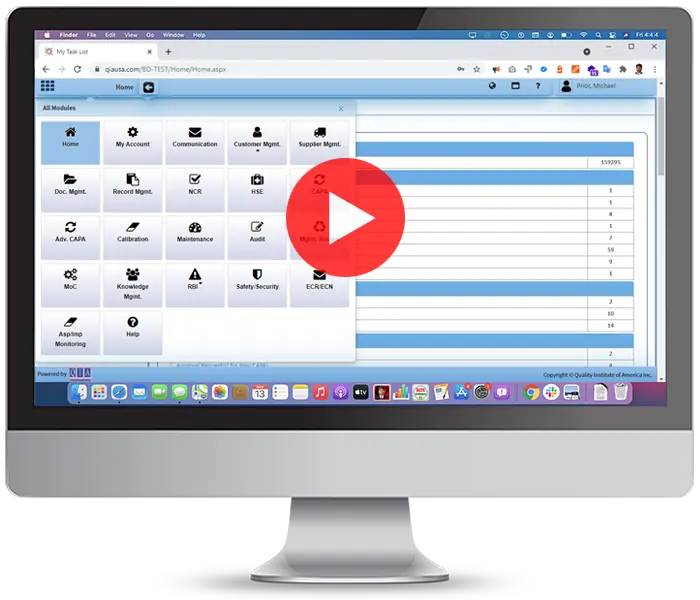Management of Change Software System
ISO standard based QMS QISS Offers Management of Change Software System for your company.
This writing will discuss a Management of Change Software System of an ISO (International Organization for Standardization) standard-based quality management software QISS.
What is the QISS Management of Change (MOC) System?
The Management of Change module in QISS will help companies exercise the care and discipline necessary for implementing changes with the least amount of risk and ensure that the intended improvements are achieved fully.
Like all modules in QISS, the Change Management module is easily set up and allows the user to create Management of Change (MOC) Groups. These groups are essential in determining the planning stages of changes to be made to the organization’s QMS. The user may also create change types, thus describing, generally, the various types of changes that will describe areas affected. Examples include operational changes, transitional changes, procedural changes, etc.
Features and Benefits of QISS Management of Change (MOC) System
Activities by authorization: QISS is permission-based software, and only authorized users can perform an activity. The module manager or one of his/her higher authorities is responsible for granting MoC activities permissions.
Approvers for change type: QISS allows predefining approvers for a type of change or selecting them on-the-fly during initiation of MoC.
Ability to initiate MoCs of different origin: Internal, customer, and supplier MoCs can be initiated by authorized users.
MoC options: Options allow certain levels of customization. You can use options to modify the default settings provided by QISS. For example, by default, approval for verifying effectiveness is performed by the responsible person of the MoC. It can be modified so that initiator of that MoC would perform that task.
Ability to add custom fields: In addition to standard fields provided by QISS, such as department, origin, and input name, authorized users can add custom fields.
Responsible person for each MoC: When an MoC is approved for action, a responsible person is assigned, and that person is responsible for completing the risk assessment and implementation plan. He or she is also responsible for coordinating implementation and verification of effectiveness as well as performing final approval. After final approval, MoC will be closed or sent for final verification depending on whether final verification is requested by the user who assigns the responsible person.
Ability to control implementation step assignment: Depending on the MoC option, an organization can control whether the implementation step needs approval before proceeding to verification of effectiveness. If the implementation step doesn’t need approval, the verification of effectiveness step also can be assigned with it. If both steps are assigned together, MoC will be sent to the approver of the verification of effectiveness step.
Ability to control approvers for implementation and verification of effectiveness steps: QISS defines a responsible person as the default approver for implementation and verification of effectiveness steps. So, whenever one of these steps has been completed as the last assigned step, MoC will be sent to the responsible person for approval. However, authorized users can modify the defaults and change approvers.
MoC dashboard: Users can view the status of open MoCs in the MoC dashboard. It includes required action, due date, and the user and MoC is waiting for action.
Edit capabilities: Authorized users can perform edit activities to modify existing information in MoCs. MoCs also can be deleted.
Email notifications: QISS sends email notifications related to all MoC activities.
Charts & Reports: QISS provides customizable activity, timeliness, and aging charts and reports for MoCs.
The history of the QISS Management of Change (MOC) System
Managing Changes to the Quality Management System has always been part of QMS standards but usually was thought to be a process of documenting changes. Over the last decade, and after major disasters in different industries, there has been a heightened sensitivity towards risk. This, in turn, has translated into QMS Standard requirements getting more stringent. The American Petroleum Institute (API) is notable for its elevated requirements in API-Q1.
The MOC module was designed to provide organizations with the best practice tool to address changes in their QMS and manage these changes by documenting the actions and decisions that govern the changes. QISS helps companies do this with the incorporation of Risk Assessments in the process
The module contains a work-flow that allows the user to initiate and assign various tasks related to managing changes in the QMS and documents all actions taken and the persons involved with the assigned tasks.
The MOC module is new to the QISS suite but is designed with the same work-flow as all the modules contained within the QISS QMS software package. By using the MOC module, all requirements of ISO 9001:2015 are accounted for, and the organization will possess a powerful, dependable, and effective tool for managing changes within its QMS.

